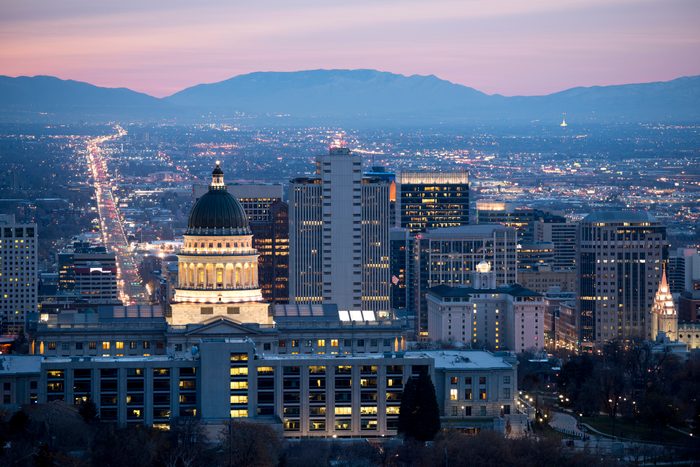
A capital history
When you were in elementary school, your teacher probably gave you a state capitals quiz to test if you knew every capital in the country. Chances are, you still remember more than a few of them, as well as knowing many of the state nicknames. (For example, most people know that New York is the Empire State and Florida is the Sunshine State.) And if you’re really up on your state trivia, you might even be able to recognize some of the state flags. But here’s one detail for each state in the union you probably don’t know: how each state capital got its name.
The history of our state capitals’ names is as varied as it is storied: Some are named after presidents or notable figures, some are the stuff of legend and some seem obvious (hello, Oklahoma City) but really have more to them than that. Many of our state capitals provide us with the best weekend getaways in the country, the best tourist attraction in every state and even hidden gems. Let’s honor their heritage by diving a bit deeper into the stories behind the naming of every state capital.
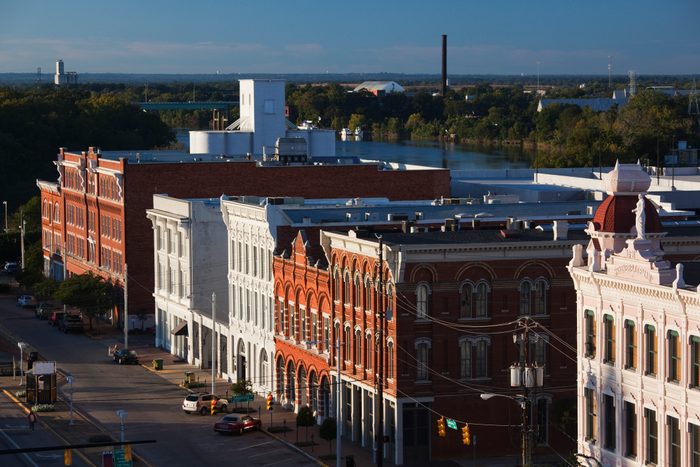
Montgomery, Alabama
Montgomery was named for General Richard Montgomery, a Revolutionary War hero who was killed in battle—even though he never lived in the area. In 1819, the year Alabama became a state, two small settlements merged to form a town named after the general. In 1822, the city became the county seat (interestingly, Montgomery County was named after a different army major, also named Montgomery). In 1846, Montgomery became the capital of the entire state. Today, Montgomery’s governor’s mansion is one of the country’s most beautiful mansions.
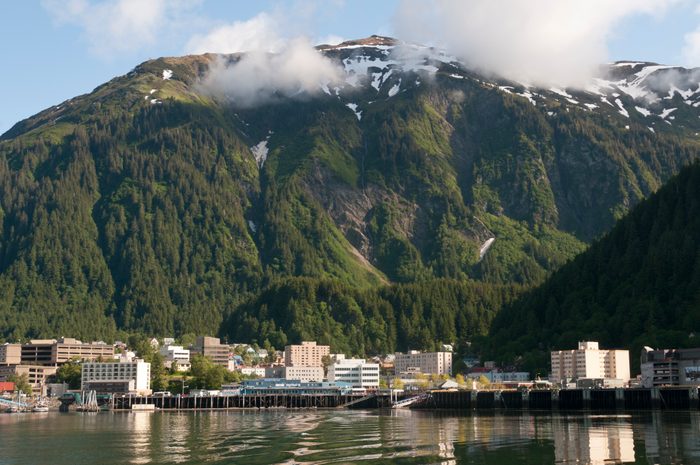
Juneau, Alaska
Joseph Juneau discovered gold in Alaska in 1880 with his prospecting partner, Richard Harris. When other prospectors flocked to the area, Harris named the resulting town after himself: Harrisburg. It was briefly renamed Rockwell, ostensibly because there were too many towns in the U.S. named Harrisburg. But Joe Juneau felt something in the town should be named for him, and in 1881, he garnered enough support to change the name to Juneau. In 1906, the city became the territory capital; Alaska officially became a state, and Juneau the state capital, in 1956. Today, Juneau’s natural beauty is offset with one of the strangest roadside attractions in America.
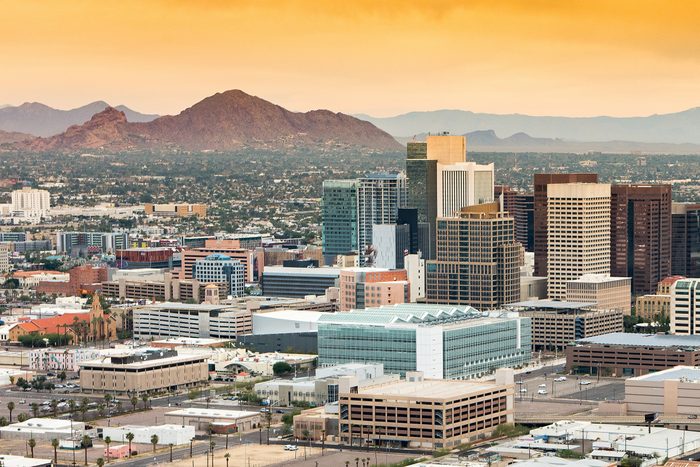
Phoenix, Arizona
The city of Phoenix was built on the ruins of the Pueblo Grande settlement, occupied between 700 and 1400 A.D., until it was destroyed, most likely by drought. In 1867, Jack Swilling of Wickenburg, Arizona, introduced irrigation to the area, then known as Swilling’s Mill. Another city pioneer, Darrell Duppa, suggested the name of Phoenix after the mythical bird that rose from the ashes, just as the new city arose from the grounds of an ancient one. The name became official in 1868. Phoenix became the territory capital in 1889, and Arizona became a state in 1912.
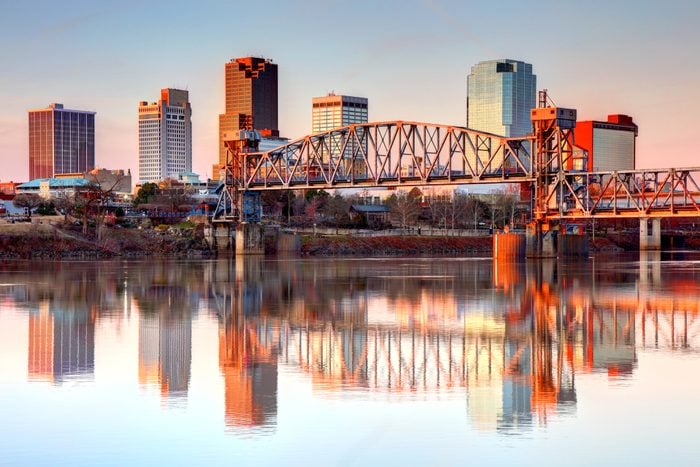
Little Rock, Arkansas
Bernard de la Harpe, a French explorer from New Orleans, noticed an outcropping of rock along the banks of the Arkansas River—the first he had seen since leaving New Orleans—which he called la petite roche (translation: “the little rock”). In 1803, the United States purchased this area, which was then part of the Louisiana Territory, from France (although it was still occupied by Native Americans). In 1818, boundary lines defining what’s now Arkansas were drawn via a treaty that referred to this spot as “Little Rock,” and the name stuck. The settlement was designated as the territorial capital in 1820, and in 1836 Arkansas became a state. Fun fact: Skippy peanut butter comes from Little Rock. Check out these other favorite foods from every state.
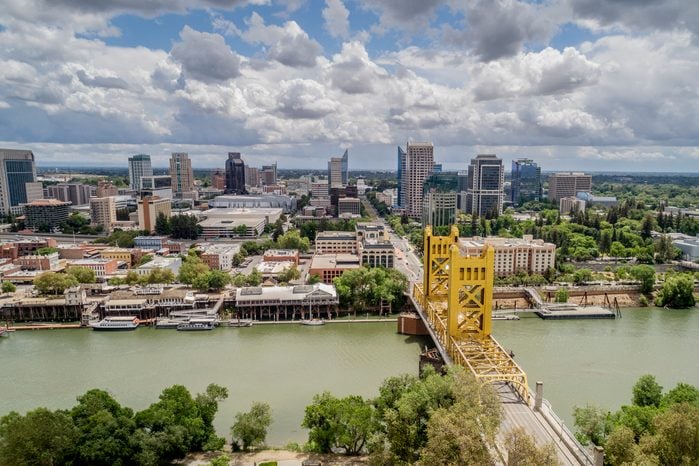
Sacramento, California
In the first decade of the 19th century, Spanish explorer Gabriel Moraga named the Rio de los Sacramentos, or Sacramento River, after the Spanish word for “religious sacrament.” The settlement bordered by the Sacramento River later became known as Sacramento as well, and it was designated the state capital in 1854. Today, it’s one of the capital cities people always get wrong.
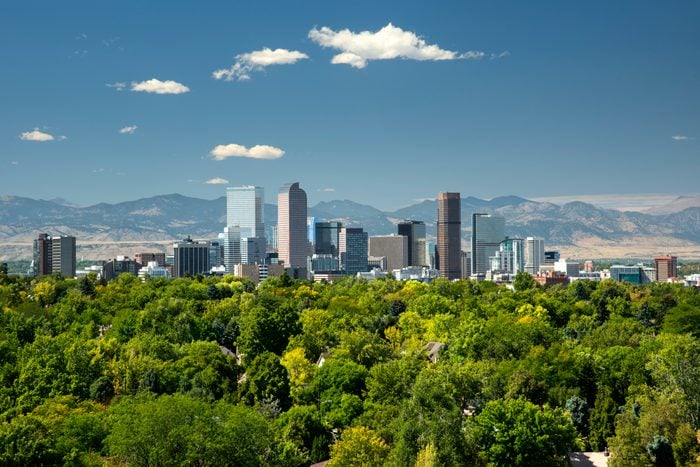
Denver, Colorado
In 1858 a group of prospectors crossed the plains of eastern Colorado and found gold at the base of what are now the Rocky Mountains. The gold rush that followed was relatively small, but a city founded by Kansas man William H. Larimer quickly sprung up. Larimer named the town after the most recent governor of the Kansas Territory, James Denver, hoping to curry favor (he didn’t know Denver had already resigned!). Colorado became a territory in 1861 and a state in 1876; Denver was designated the capital in 1881. You probably already know Denver’s quirky nickname, the “Mile-High City,” so called because of its elevation, but do you know the most charming small town in Colorado?
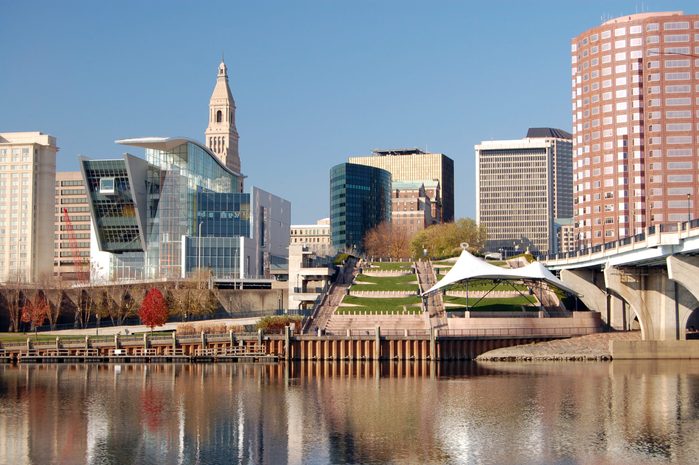
Hartford, Connecticut
The area around present-day Hartford had been known by the Native Americans as Saukiog. When the Dutch arrived in the 1620s, they called the fort they established at Saukiog the House of Hope. In 1635, the English arrived via Massachusetts and created a settlement to the north of the Dutch, which they briefly called Newtown before changing it to Hartford, possibly because one of the founders became nostalgic for his hometown of Hertford, England (or as it was usually spelled then, Hartford). It became the sole state capital in 1875 after having been co-capital with New Haven since the Colonial period. Here’s a random yet astonishing state fact: Hartford is home to the nation’s oldest continually published newspaper, The Hartford Courant, which began publication in 1764.
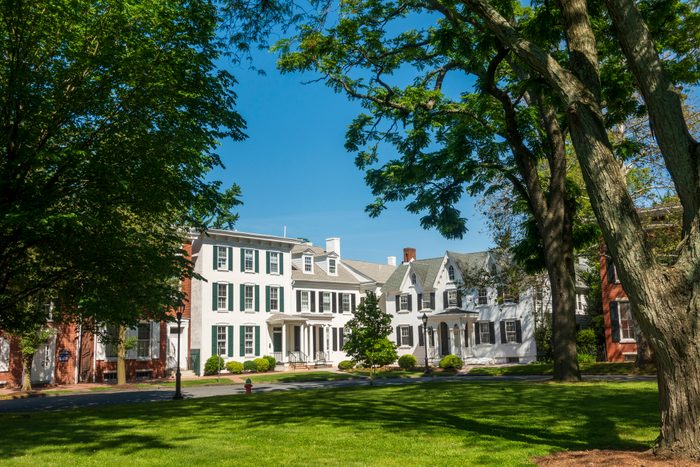
Dover, Delaware
Like Hartford, Dover was named for a place in England: Dover, famous for its white cliffs. The town was proposed and named in 1683 by William Penn, who also gave his surname to Pennsylvania, if you’re wondering how every state got named. He planned to hold a courthouse in the town as well—a big deal in Colonial times, which set up Dover as a seat of power. Dover was laid out as a city in 1717 and became the capital of Delaware in 1777, when it was moved from New Castle farther inland to be better protected.
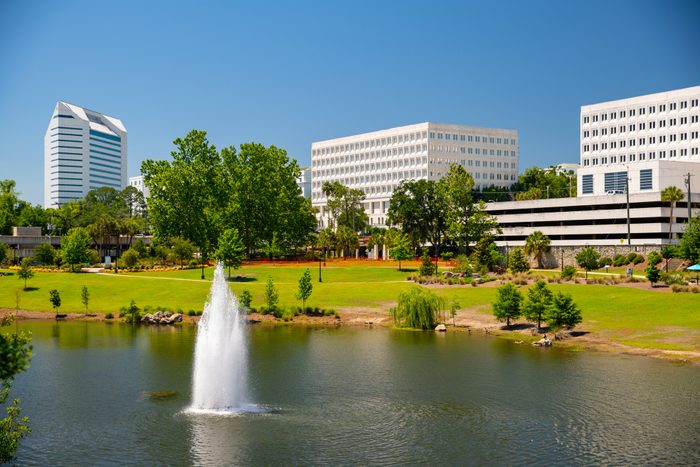
Tallahassee, Florida
Tallahassee is a Native American word for “old fields,” and it got its name from the Apalachee who had originally inhabited the area, since the year 500. It’s a hard word to spell, and for that we can thank Octavia Walton, daughter of the territorial secretary of the Florida Territory, or so the legend goes: She chose to keep the name for the new territorial capital and proposed its spelling in 1824. The site was chosen as capital because it’s halfway between St. Augustine and Pensacola, the two biggest cities at the time. Florida became a state in 1845. Today, you’ll find Florida’s entry for the best hot dog in every state in Tallahassee.
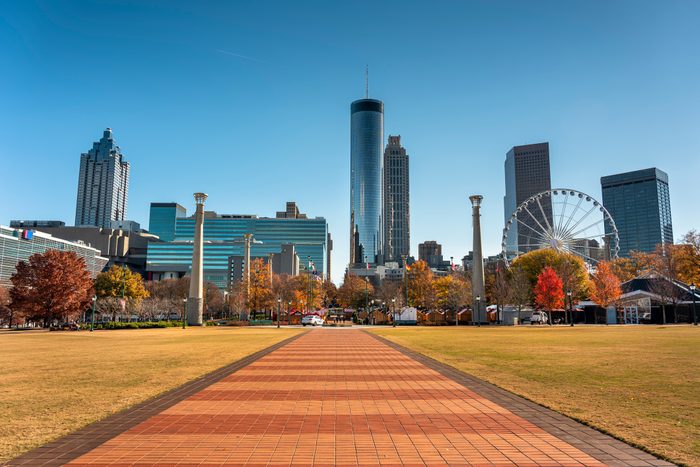
Atlanta, Georgia
Atlanta was founded in 1837 at the end of the Western & Atlantic railroad line, initially and aptly named Terminus. In 1843 it was renamed Marthasville, in honor of the then-governor’s daughter, Martha Lumpkin. At last, in 1845 the city received its final moniker, “Atlanta,” after the rail line—but Governor Lumpkin claimed “Atalanta” was Martha Lumpkin’s middle name and that the city was still named for her. Martha herself admitted Atalanta was her childhood nickname but thought it simply a coincidence that it was so close to the city’s new name. After Atlanta was burned during the Civil War, the rebuilt city became state capital in 1868. Today, Atlanta has the busiest airport in the world.
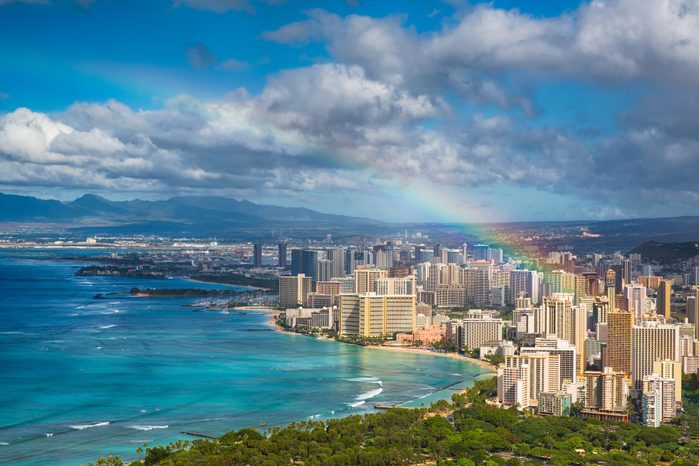
Honolulu, Hawaii
The word Honolulu means “protected bay” in the Hawaiian language, and it’s thought that there has been a settlement in the spot since the 12th century. Despite English colonists wanting to call it Fair Heaven or Brown’s Harbor (after Captain William Brown, who landed there in 1778), the Hawaiian name for the city stuck, and it was ultimately declared capital of the Hawaiian kingdom by King Kamehameha III in 1850, more than a hundred years before Hawaii became a state in 1959.
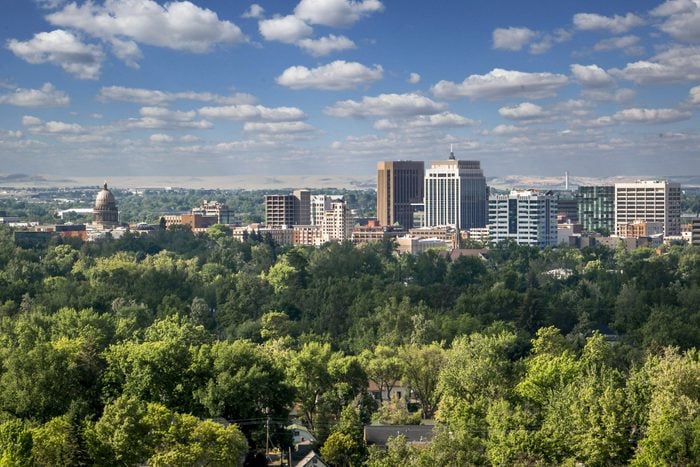
Boise, Idaho
Boise (pronounced “boy-see” by locals, not “boy-zee”) is a French word that means “wooded,” which, legend has it, is what 19th-century French Canadian fur trappers exclaimed when they saw the tree-lined banks of the Boise River: “Les bois!” It appeared like an oasis after crossing the plains of the eastern part of the state. Some accounts say they called it “la rivière boisée,” which means “the wooded river.” Even today, Boise is known as the “City of Trees.” In 1864, a year after Idaho Territory was established with Lewiston as the capital, that distinction moved to Boise, and Idaho became a state in 1890. Today, Boise’s old Idaho State Penitentiary is one of the spookiest abandoned places.
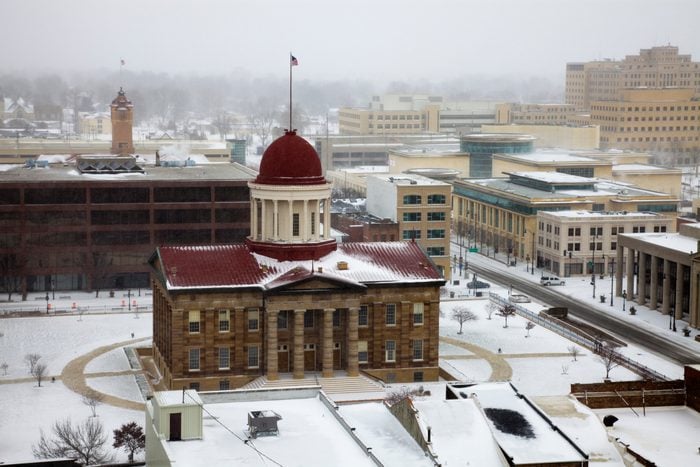
Springfield, Illinois
Famously the home of future president Abraham Lincoln, Springfield was originally named Calhoun in 1823, for U.S. Senator and former Vice President John C. Calhoun, although some sources say it was called Springfield even though that wasn’t its official name. But in 1832, it was officially renamed, supposedly for the nearby Spring Creek—though alternate stories say it was named after the progressive town of Springfield, Massachusetts, or maybe even Springfield, Kentucky. Springfield was actually the third capital of Illinois, after Kaskaskia, which was prone to flooding, and Vandalia. In 1839, legislators including Lincoln successfully campaigned to move the capital farther north to centrally located Springfield. Today, Springfield’s Abraham Lincoln Home is one of the most historic landmarks in the United States.
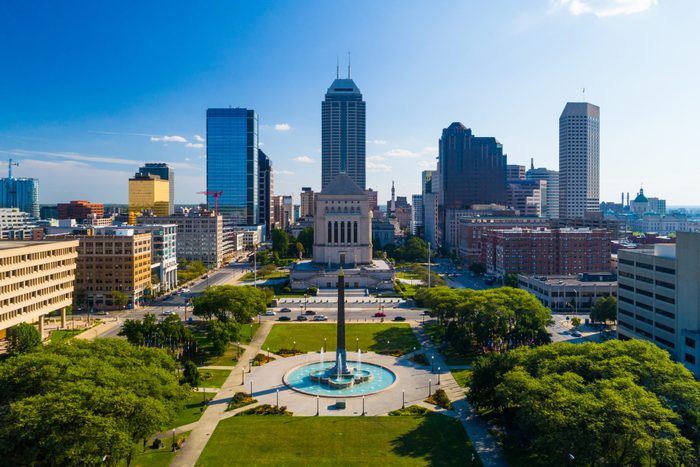
Indianapolis, Indiana
The root of the name Indianapolis, like that of Indiana, likely refers to the “Indians” (or Native Americans), the indigenous people who populated the land before white settlers. Polis is the Greek word for “city.” The state of Indiana was admitted to the U.S. in 1816, and the city was built to be the state capital, which it officially became in 1825. Today, the city’s Indianapolis Motor Speedway is one of the most popular tourist attractions in the country.

Des Moines, Iowa
This capital city is named after the Des Moines River, but no one is really sure how the name of the river originated, or whether the origin is French, Native American or some combination of the two. It’s been alternately suggested that French meanings may be “river of the monks” (des moines), although no monks lived there, or “river in the middle” (de moyen), because it’s between the Missouri and Mississippi Rivers.
The first mention of the name from a European was by a French fur trader who wrote that Native Americans told him a tribe called the Moigwena (corrupted in French to “Moines”) lived up the river. However, in a recent controversial scholarly paper, one linguist claimed that the Native American meaning of that word is “excrement faces.” Is it possible they were playing a little joke on the fur trader? We’ll never know. Des Moines became the state capital in 1857, and today the city famously has one of the best state fairs.
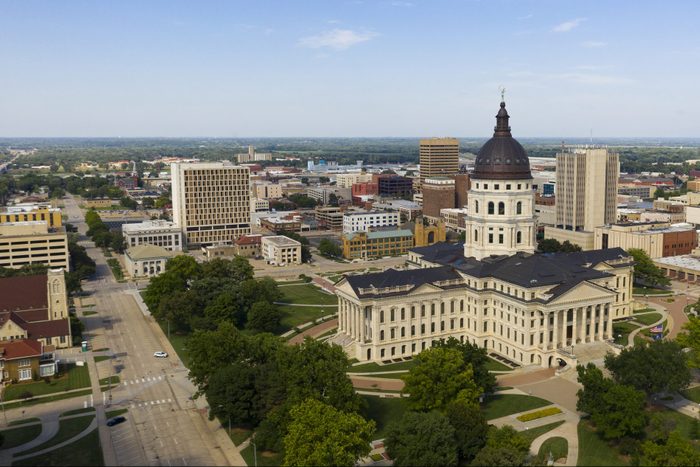
Topeka, Kansas
Some say Topeka is from a Native American word meaning “a good place to dig potatoes.” Others say it’s a made-up word. What’s known for certain is the city was founded on Dec. 5, 1854, but no one could agree on a name at the time. Among the rejected options: Webster (after famous orator Daniel Webster), Mid-Continent (because of its geographical location) and Papan’s Ferry (in reference to the local Papan family, who had originally established a crossing over the Kansas River at the site). We also know that the name Topeka, whatever its origins, ultimately won out. When Kansas became a state in 1861, Topeka was chosen as capital. Today, Topeka has one of the country’s best RV parks.
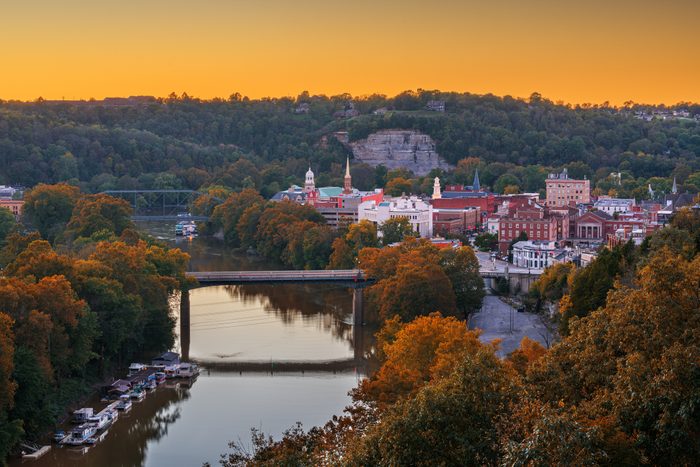
Frankfort, Kentucky
Frankfort has nothing to do with the similar-sounding German city and everything to do with Stephen Frank, a local settler who was killed during a skirmish with Native Americans in 1780. Because of a ford along the river that ran through the area, a Buffalo trail that led the way for settlers, “Frank’s Ford” seemed a good choice. In 1786, the name was shortened to Frankfort, and it beat out other cities to become the capital when Kentucky became a state in 1792. Today, the charming city is located in the heart of Kentucky’s Bourbon Trail, one of these epic road trips for foodies.
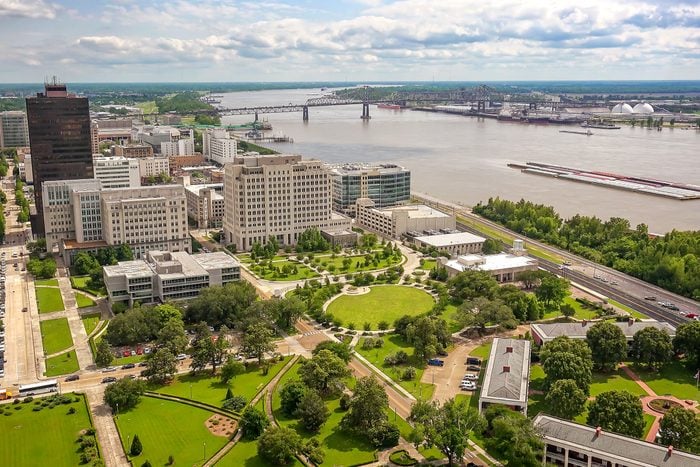
Baton Rouge, Louisiana
Baton Rouge sounds French because it is. In 1699, French explorer Pierre Le Moyne d’Iberville described a “red stick” along a Mississippi River bluff—in French, “le baton rouge.” This stick was actually a cypress pole erected by two Indigenous tribes to mark the boundary line that divided their hunting grounds. The pole was hung with animal parts and was thus red from the blood. Today, a sculpture of The Red Stick marks the spot. Baton Rouge was chosen as Louisiana’s capital in 1849.
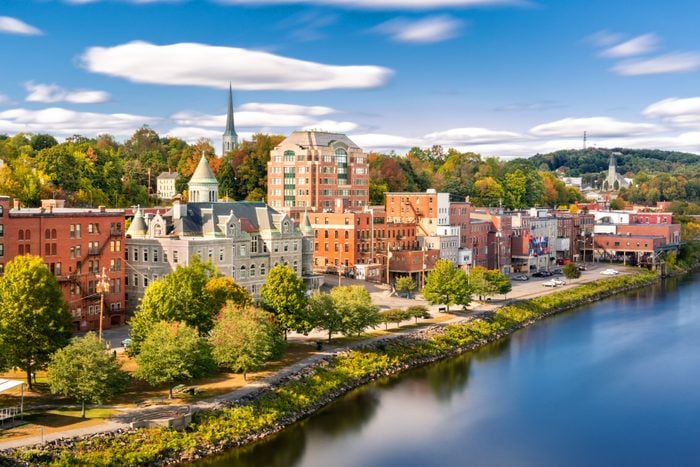
Augusta, Maine
The area that would eventually become Maine’s state capital was first explored by English settlers in 1607, and a trading post was established by people from Plymouth Colony around 1628. They called it Cushnoc, a Native American word for “head of tide,” because of its location on the Kennebec River at the tidehead (the point upstream from the ocean where the river is no longer affected by the tide). The trading post was abandoned and not inhabited by colonists again until Fort Western, now the oldest wooden fort in the U.S., was built in 1754. The town was incorporated in 1797 and briefly called Harrington before its name was changed to Augusta, after the daughter of military general, politician and Maine’s first U.S. Marshal, Henry Dearborn. Maine became a state in 1820, and Augusta was chosen as the capital in 1827.
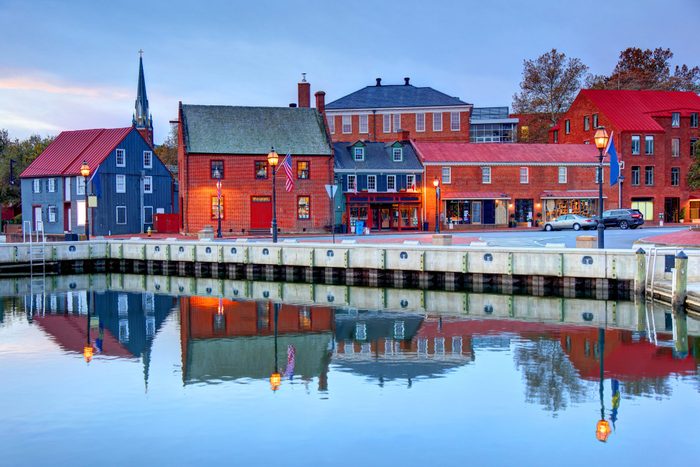
Annapolis, Maryland
Like Indianapolis, Annapolis incorporates the Greek word for city, polis, and has been called the “Athens of America” for its wealth of cultural activities. The town was first called Providence when it was settled by Puritans, and later “Anne Arundel’s Towne” after the wife of Lord Baltimore, Maryland’s first proprietary governor, who ran the colony from England. In 1694, Maryland governor Francis Nicholson moved the capital here from St. Mary’s City. He laid out new city plans and named it Annapolis after the future queen of England, then-Princess Anne. Today, Annapolis is one of the best Christmas towns when decked out for the holidays.
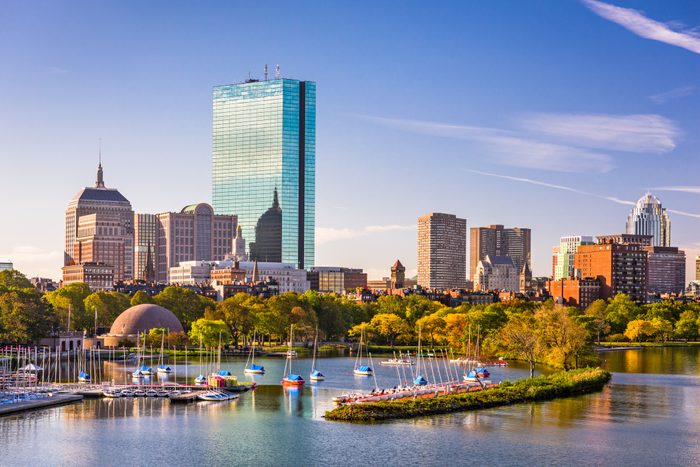
Boston, Massachusetts
Boston is another capital named after a place in England: Boston, in Lincolnshire, where many of its most prominent first settlers came from. Prior to that, though, it was called Trimountain or Tramount, because of three low hills in the area (only one remains, Beacon Hill). Boston, England, is thought to be named after St. Botolph, as a shortened form of “Botolph’s town” or “Botolph’s Stone”; a church in that city is still named after the saint. Boston has been the capital of Massachusetts since the town’s founding in 1630. Fun fact for dog lovers: The Boston terrier is Massachusetts’s entry for the most popular dog breed in every state.
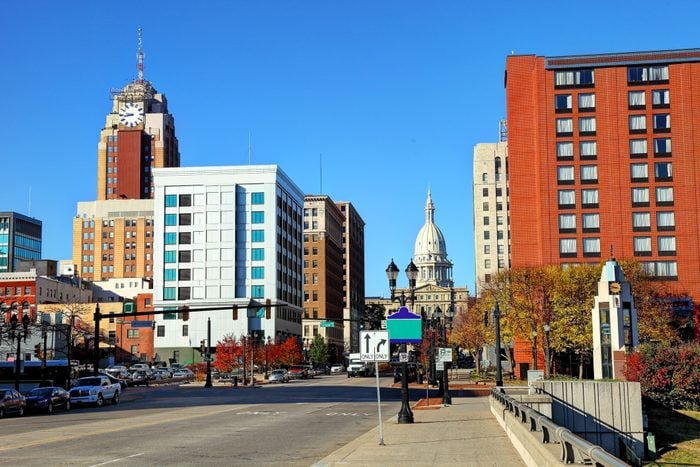
Lansing, Michigan
In the 1830s, two brothers defrauded people in Lansing, New York, into buying land in Michigan that was flooded for most of the year, calling it Biddle City. When the scam victims arrived and found their land underwater, they found a nearby place to settle and called it Lansing, in honor of their former home in New York (itself named after politician John Lansing). Michigan became a state in 1837, and the capital moved from Detroit to Lansing in 1847. Today, Lansing is one of the best places to live in the United States.
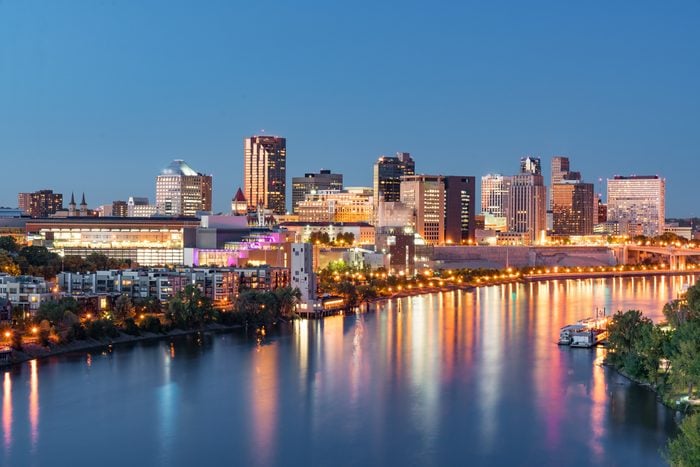
St. Paul, Minnesota
In 1680 the Franciscan missionary and explorer Louis Hennepin took note of the land that would become Minnesota’s state capital, but no land claims were made there until 1838. The claimant was a tavern owner by the name of Pierre “Pig’s Eye” Parrant, and thus, the community became known as Pig’s Eye Landing. But in 1841, a Catholic missionary from France built a log cabin chapel dedicated to the apostle Paul and renamed the town for St. Paul. In 1849, it became the seat of Minnesota’s government, and Minnesota became a state in 1858. Today, St. Paul has one of the country’s best zoos.
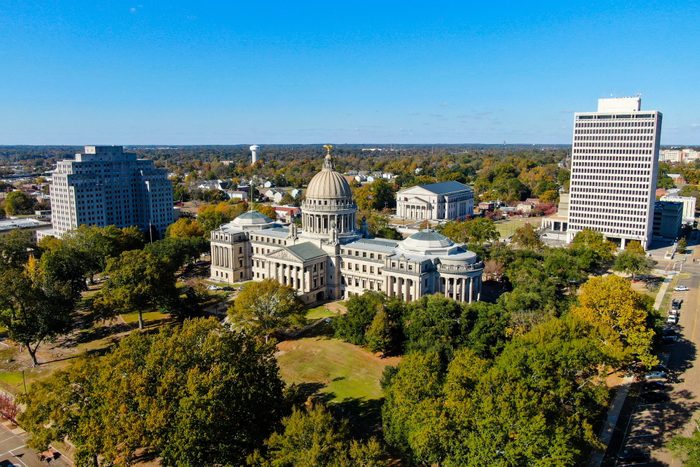
Jackson, Mississippi
First a trading post called LeFleur’s Bluff after the tradesman who established it, Louis LeFleur, the site was chosen as the Mississippi state capital in 1821, four years after Mississippi became a state. The city was named for future U.S. president General Andrew Jackson, known at the time as a national hero for defeating the British at the Battle of New Orleans, the last major battle of the War of 1812. Weird but true fact: Mississippi’s most famous invention came when a chemist walked through a forest outside Jackson, and the idea for Pine-Sol was born.
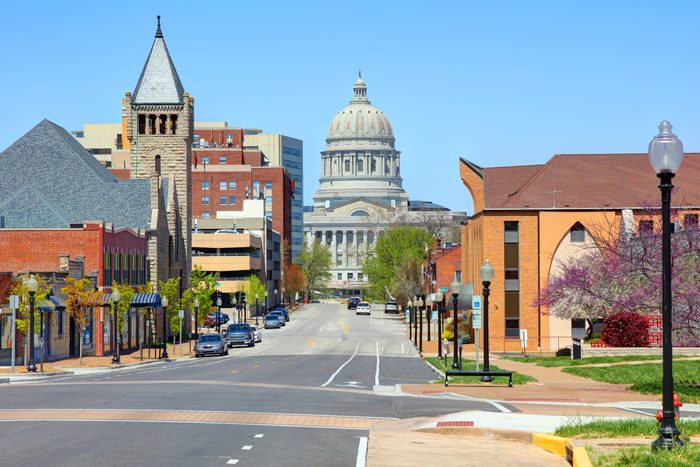
Jefferson City, Missouri
Jefferson City was also chosen specifically as the site for the new state capital, in 1821, just after Missouri became a state. The city was laid out by Daniel Morgan Boone, son of the famous frontiersman, and named for President Thomas Jefferson. There were ups and downs, however, as other towns attempted to move the capital, and in 1837, the capitol building burned down. But Jefferson City endured and remains today as Missouri’s state capital.
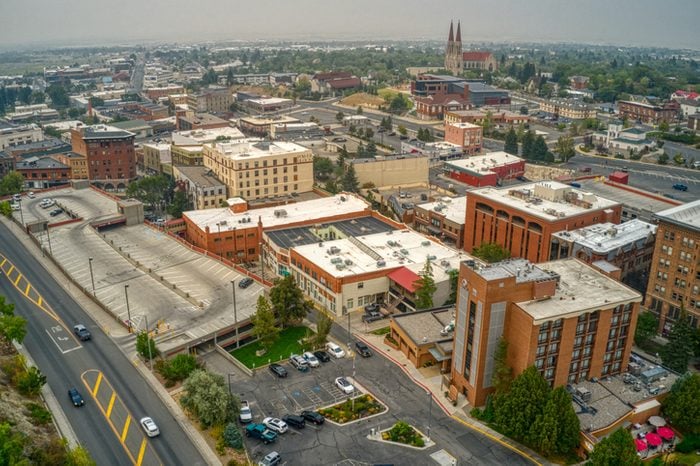
Helena, Montana
Montana’s state capital was originally named Crabtown after one of the four prospectors who found gold on what’s now Helena’s main street, which they called “Last Chance Gulch.” As more people moved to the town, they decided to rename it St. Helena after a town in Minnesota where some of them were from. It was eventually shortened to Helena. (Reportedly, other names were floated, including Pumpkinville and Squashtown, as their meeting was close to Halloween.) Helena became territory capital in 1875 and retained the honor when Montana became a state in 1889. It’s also one of the place names you’re probably mispronouncing.
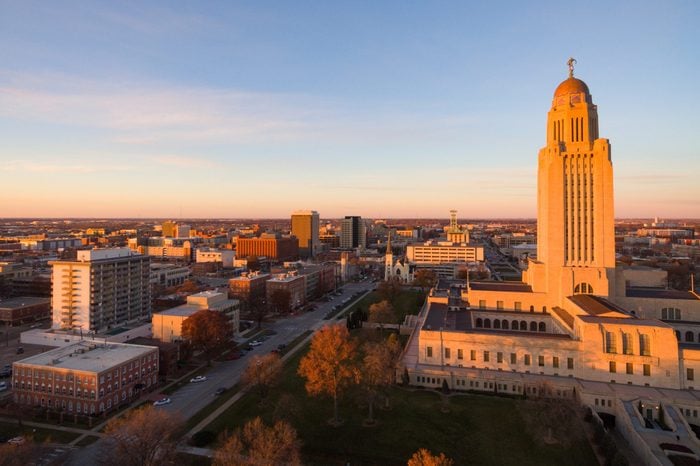
Lincoln, Nebraska
You probably can guess that Lincoln, Nebraska, is named for President Abraham Lincoln, but how that happened is where things get interesting. Nebraska became a state in 1867, setting off a fight over where to locate the state’s capitol building. Those in the north wanted it to remain in Omaha. Those in the south wanted it to be in the small village of Lancaster (named after the town in Pennsylvania) to avoid having to cross the Platte River to get to Omaha. The story goes that to discourage pro-Lancaster voters, many of whom had supported the South in the Civil War, the name was changed to Lincoln. But the strategy failed (obviously!).
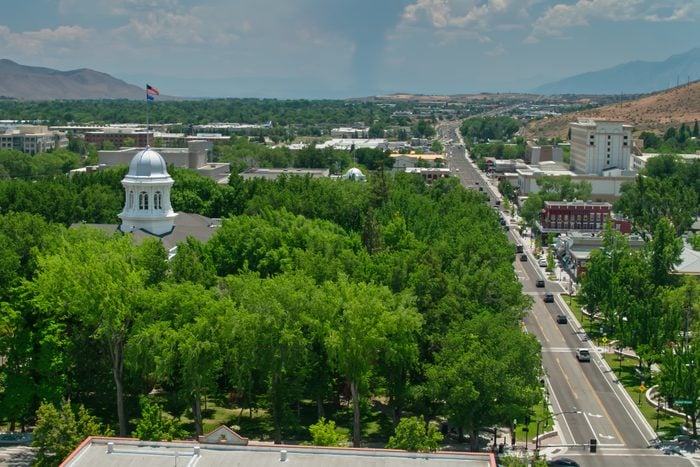
Carson City, Nevada
Carson City was named for “mountain man,” scout and Union soldier Kit Carson, who led the explorer John C. Fremont on three expeditions through the Rocky Mountains in the 1840s. Fremont named the nearby river after Carson, and a trading post was established there in 1851 called Eagle Station. When a town was founded at the spot in 1858, it was named Carson City and laid out with a site for a capitol building by forward-looking pioneers. Nevada became a territory in 1861, with Carson City as its capital; the city retained the honor when Nevada was made a state in 1864. One of the oldest cities in Nevada, Carson City also contains one of the oldest cemeteries in the country.
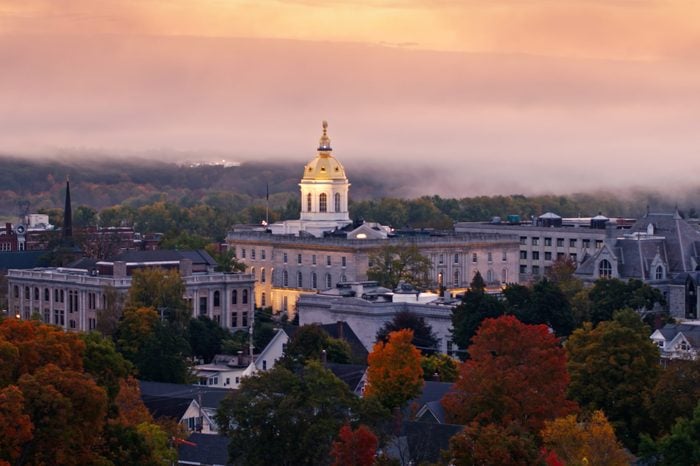
Concord, New Hampshire
The community that became Concord was settled in 1726 by a group from Haverhill, Massachusetts. In 1733, it was incorporated as Rumford, after a town in England. But after a bitter boundary dispute between Massachusetts and New Hampshire over who should have dominion over the area where the town was located, Rumford became Concord, which was intended to reflect the new “concordance” of the resolution. The city became the state capital in 1808. Fun fact: Concord was home to the Rumford Press, at one time the third largest printer in the nation, and the one that printed Reader’s Digest.
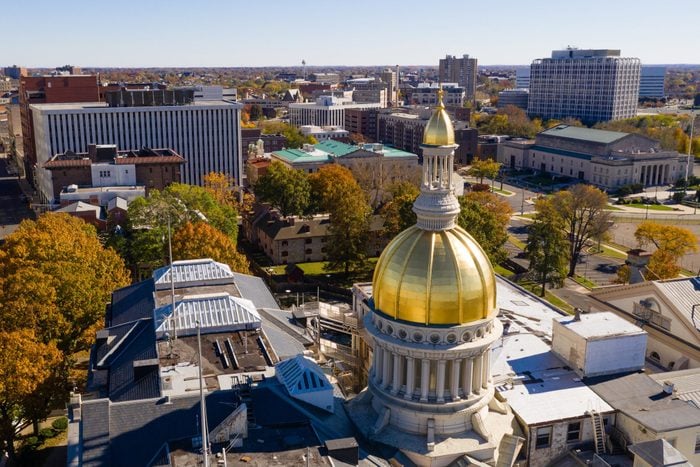
Trenton, New Jersey
Here’s one of the not-so-surprising facts about George Washington: Trenton is the site of Washington’s first victory in the Revolutionary War, after the general crossed the Delaware River and arrived there for a surprise attack on Dec. 25, 1776. But surprisingly, Trenton was nevertheless named for someone else: William Trent, one of the leading landowners in town, in 1719. Initially, it was called Trent Town, which eventually became consolidated into its current form. Trenton became the capital of New Jersey in 1790.
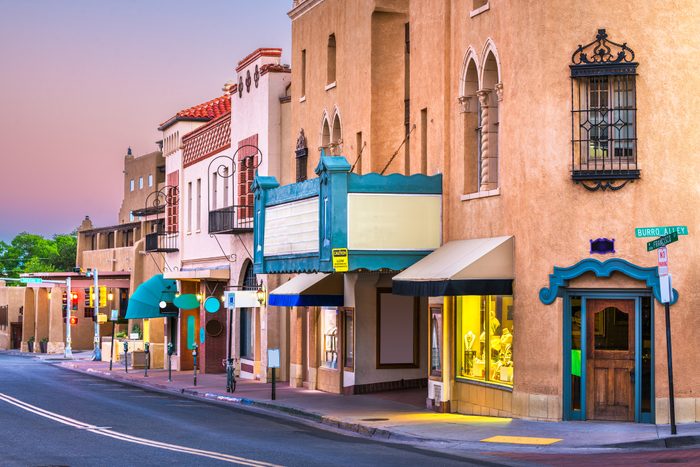
Santa Fe, New Mexico
Santa Fe, which means “Holy Faith” in Spanish, is the oldest state capital in U.S.: The city, the second oldest in the country, was founded in 1610. It was a Spanish capital, a Mexican capital, the American territorial capital and, finally, the U.S. state capital from 1912. Sante Fe is not exactly the name that was intended by the man who christened it, however: New Mexico’s first governor under Spain, Don Pedro de Peralta, wanted it to be known as “La Villa Real de la Santa Fe de San Francisco de Asís,” which means “The Royal City of the Holy Faith of Saint Francis of Assisi.” The much shorter Santa Fe works just fine though. Today, sunny Santa Fe is a top winter destination.
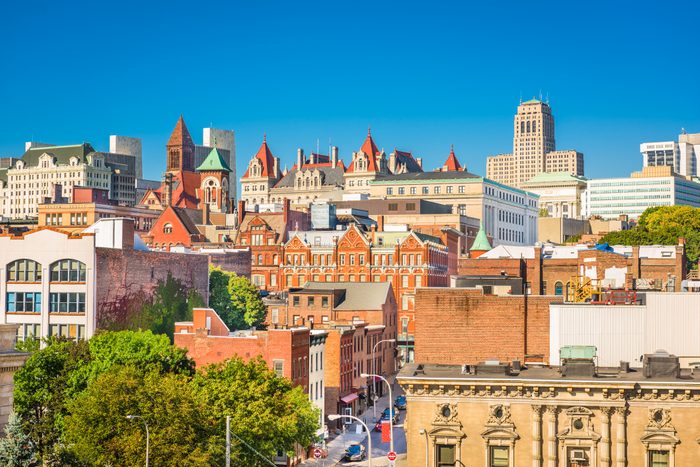
Albany, New York
One of the oldest historic towns in the country, Albany is the longest continually occupied European settlement in the eastern United States. It was originally known in the 17th century as Beverwyck (“place of beavers”) because of its lucrative beaver-fur trade. Beverwyck is Dutch, reflecting that the community was, at the time, Dutch. That remained true even after the British took control of it in 1664, renaming it Albany in honor of James, Duke of York and Albany, who would eventually become King James II of England. Albany became New York’s capital in 1797.
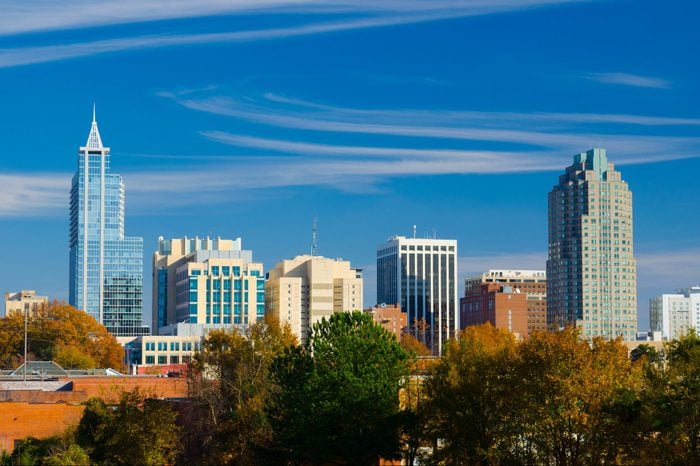
Raleigh, North Carolina
Raleigh gets its name from explorer Sir Walter Raleigh, who attempted to establish the first English colony on the shores of the “new world” in the 1580s. The city was founded in 1792 specifically as North Carolina’s state capital after the prior capital, New Bern, located near the coast, had been damaged during the American Revolution; in addition, the state’s population had begun to move west, so a more centrally located site made sense.
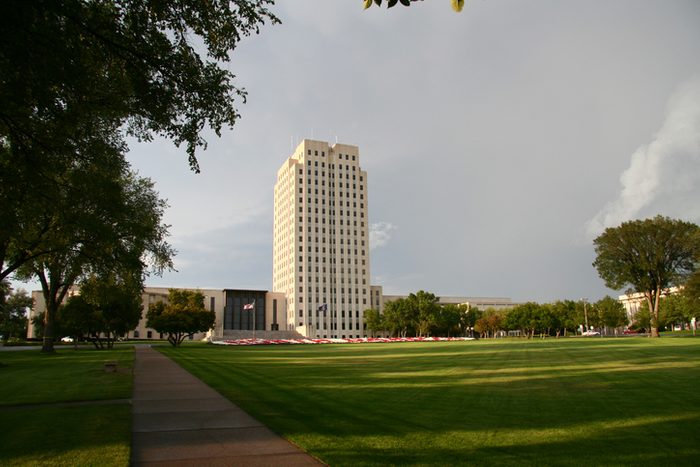
Bismarck, North Dakota
Bismarck is the only capital city named for a German chancellor, in this case, Otto von Bismarck. Originally, Bismarck had been named Edwinton in 1872, in honor of Edwin L. Johnson, a civil engineer who’d played a crucial role in developing the U.S. railroad system. The renaming, which took place in 1873, had the railroad system in mind as well: That very year, the tracks had reached Edwinton/Bismarck, which had received a large influx of German immigrants. The hope was that name-checking the chancellor would inspire German investment in the railroad. Although that didn’t come to pass, Bismarck thrived anyway, becoming capital of the Dakota territory in 1883 and of the new state of North Dakota in 1889. Today, Bismarck is home to arguably the best pumpkin patch in North Dakota.
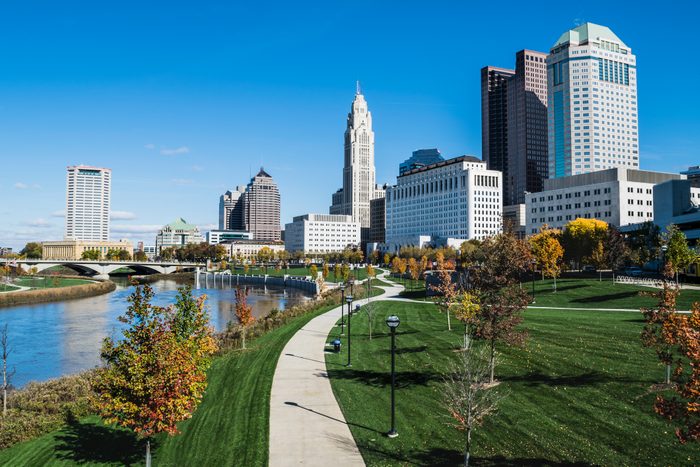
Columbus, Ohio
Columbus was planned in 1812 as the intended state capital of Ohio, moved from Chillicothe for its more central location and proximity to transportation routes. The new capital took its name from the explorer Christopher Columbus; however, in recent years, the city has chosen to distance itself to some extent from the now-controversial explorer by not observing Columbus Day and moving the city’s day off to Veterans Day instead.
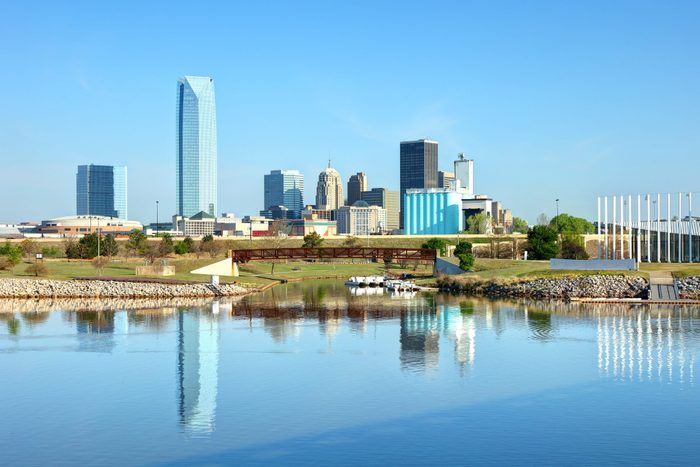
Oklahoma City, Oklahoma
Oklahoma City was founded in a single afternoon, April 22, 1889, during an event called the “Land Run,” in which the government permitted people to rush in and claim property there for themselves. If this sounds familiar to movie fans, it’s because a later Oklahoma land run (in 1893) was depicted in the 1992 film Far and Away. At the time of the 1889 land run, the area was known as the “Unassigned Lands,” and overnight, 5,000 people settled there. Townsite companies claimed land as well, and the people organized a city government. It soon became known simply as Oklahoma City. Oklahoma territory was established in 1890, with Guthrie as capital; after the territory became a state in 1907, the people voted Oklahoma City as the new state capital in 1910. Today, OKC is one of the best American cities for live music.
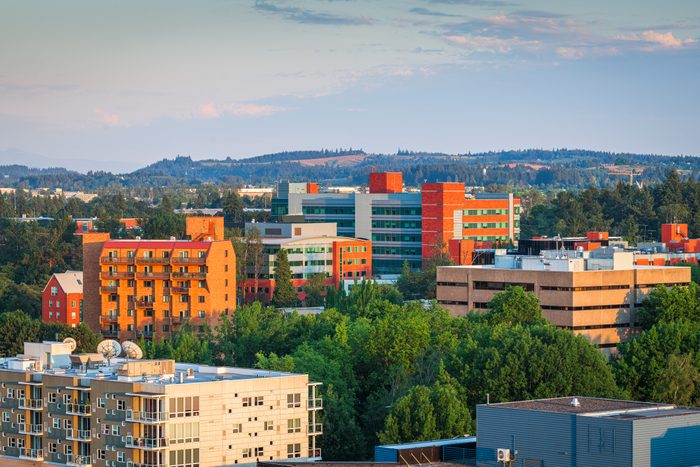
Salem, Oregon
This lovely spot on the Willamette River was originally called Chim-i-ki-ti by the Indigenous Kalapuya tribe, meaning “meeting or resting place,” and was later settled by missionaries in the 1840s. Salem, of course, is also the name of the infamous New England town that hosted the Salem witch trials, in which young women were persecuted as “witches” in the late 1600s. But it’s also the anglicized version of the Hebrew word for peace, shalom. Both factors were likely in play when the town got its name in the 1840s: One of the founders was from New England, and the religious missionaries wanted a religious name. Salem became the territorial capital in 1851 and remained so as Oregon gained statehood in 1859.
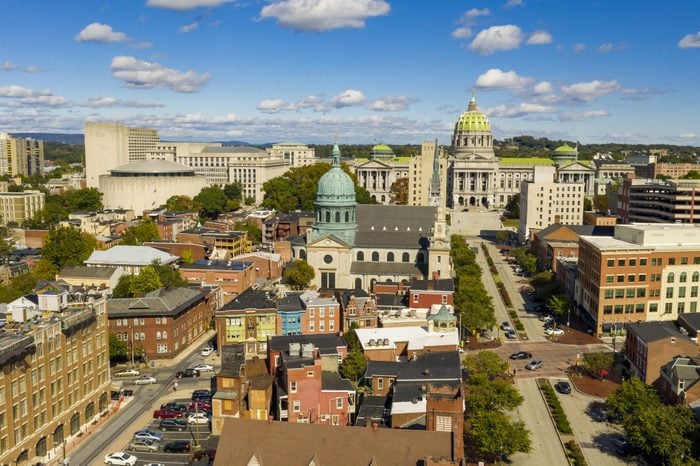
Harrisburg, Pennsylvania
In 1719, an Englishman named John Harris became one of the first Colonial settlers at the spot that would later become the state capital bearing his name. He operated a ferry crossing the Susquehanna River, so the area was called Harris’s Ferry. In 1785, his son, John Harris Jr., gave four acres of land and recommended it as the site for a new city to be the county seat, asking that it be named Harrisburg. It was incorporated in 1791 and named the state capital in 1812.
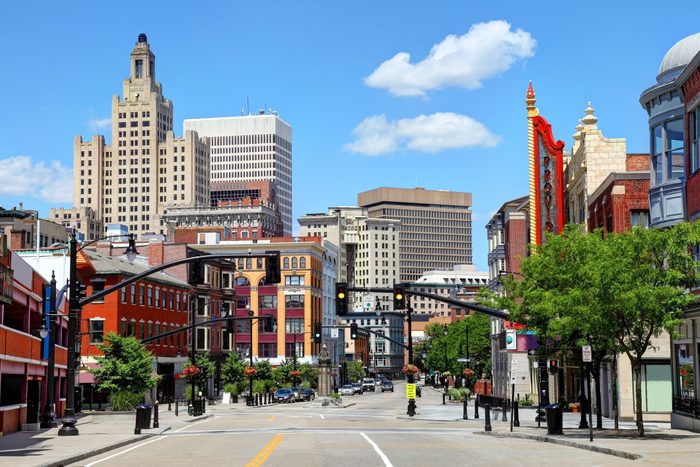
Providence, Rhode Island
Providence was founded in 1636 by the rebellious religious teacher Roger Williams, who was fleeing Massachusetts, where he’d been the victim of religious persecution. When he arrived in his new home, which he purchased from the Narragansett tribe, he called it Providence as a way of thanking God for protecting him on his journey. He established the town as a place of religious and political freedom. The naming of Providence also fits in with Rhode Island’s state motto, “Hope.” Providence wasn’t incorporated as a city until 1831 and didn’t become the sole state capital until 1901—prior to that, the state government rotated between several cities.
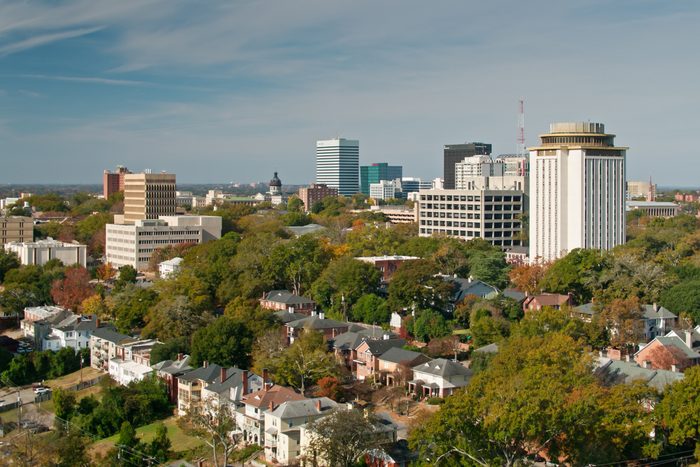
Columbia, South Carolina
Like Columbus, Ohio, Columbia, South Carolina, was named for Christopher Columbus. Settled by Europeans in the early 1700s, the site was chosen as the new state capital in 1786, with the name voted on by the senate, moving the seat of state government from Charleston on the coast to a more centralized location. Columbia was one of the first planned cities in the United States, second only to Savannah, Georgia. But you probably don’t know that Columbia wasn’t chartered as a town until 1805, or as a city until 1854. Do you know the best-kept secret in every state?
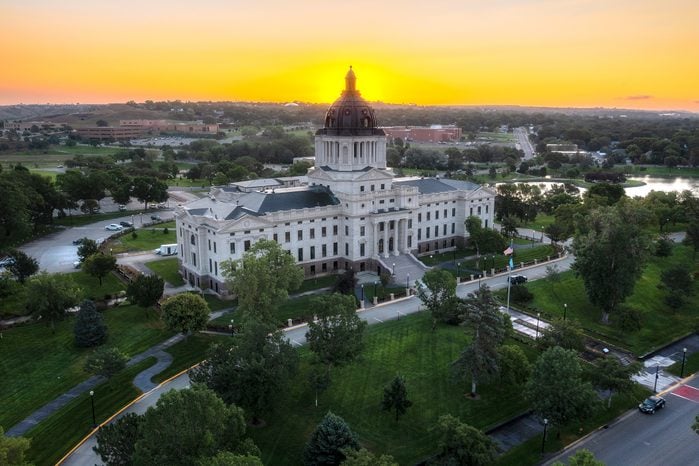
Pierre, South Dakota
The name of South Dakota’s capital city boils down to one guy: Pierre Chouteau Jr., a fur trader who established a trading post along the west side of the Missouri River called Fort Pierre in 1831 (a previous trading post had been there since 1817). The area across the river, on the east side, also began to be called Pierre as more settlers arrived during the 19th century. Officially founded in 1880, the centrally located Pierre was chosen as the state capital in 1889 when South Dakota achieved statehood.
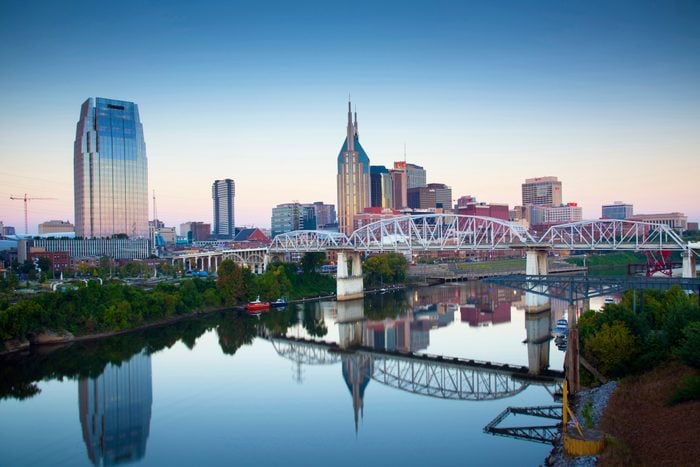
Nashville, Tennessee
When explorers in 1779 established a settlement at the site of a former trading post, they named it Fort Nashborough in honor of General Francis Nash, an American Revolutionary War hero who had died at the Battle of Germantown, Pennsylvania, in 1777. By 1784, the thriving area was renamed Nashville, and it was incorporated as a city and the county seat in 1806. It became Tennessee’s permanent capital in 1843—prior to that, the state government had been moved among several cities. Today, singing karaoke in Music City should be one of your bucket list ideas.
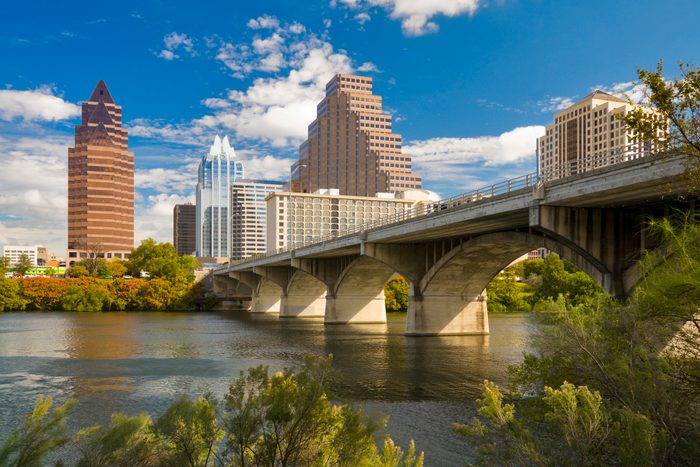
Austin, Texas
The city of Austin was planned in 1839 with the intention of its becoming the capital of the Republic of Texas, a sovereign state that existed for 10 years after independence from Mexico in 1836 and before annexation by the U.S. as a state in 1845. The site was chosen along the Colorado River at a small settlement called Waterloo and named after the founder of Texas, Stephen F. Austin, who had recruited settlers to the area. He died in 1836, just after helping Texas become independent. Although Texan president Sam Houston later moved the capital away from Austin, when Texas became a state, voters chose Austin to resume its role as capital. Located in Texas Hill Country, Austin and the area outside the city offer endless natural beauty, including one of the most gorgeous waterfalls in America.
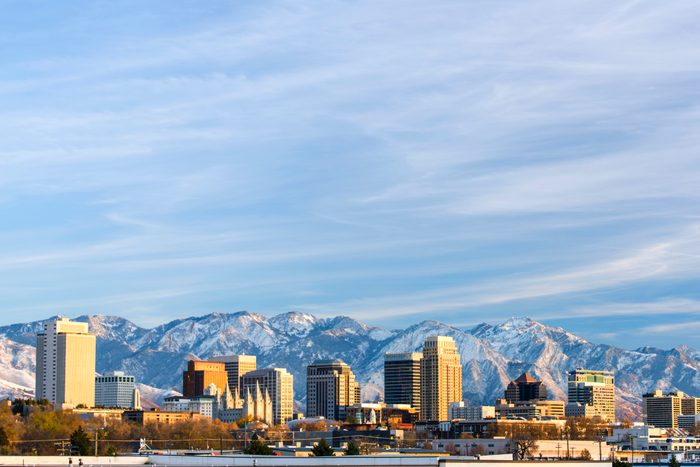
Salt Lake City, Utah
Salt Lake City was founded on July 24, 1847, by a group of 148 Mormon pioneers led by Brigham Young, searching for religious freedom. They originally called their new home “Great Salt Lake City” after the salty lake near the spot where Young’s group had decided to plant crops and create a community. After Utah became a territory, the city became the capital in 1856 and remained so upon statehood in 1896. The name of the lake remained Great Salt Lake, but the city name was shortened to Salt Lake City in 1868.
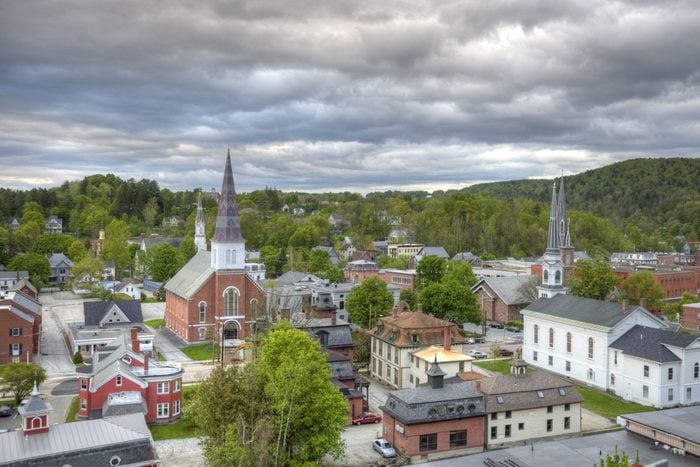
Montpelier, Vermont
The capital city of Vermont was named after the city of Montpellier, France, by Colonel Jacob Davis, one of the first non-Indigenous settlers to the area, who established the town in 1781. Vermont became a state in 1791, but Montpelier wasn’t chosen as the capital until 1805. Its central location was thought to be neutral ground for the state government’s seat, as it wouldn’t favor either those from the east or west side of the Green Mountains. Today, Montpelier is the least populous state capital.
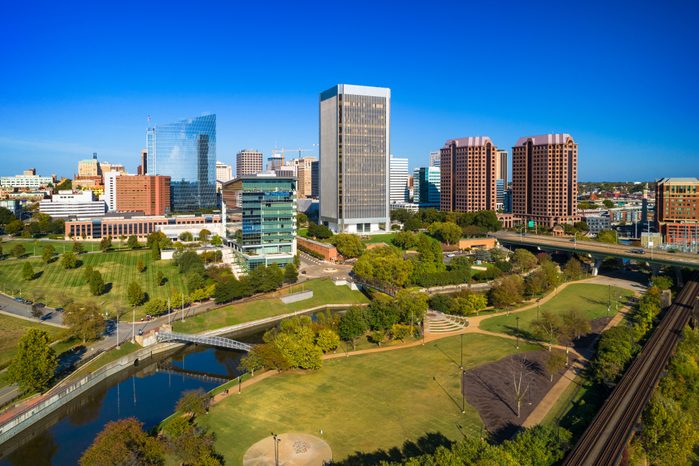
Richmond, Virginia
Another municipality that derives its name from someplace in England, Richmond was named by the town’s founder, William Byrd II, in 1737. The story goes that Byrd thought a scenic area near the James River resembled a view of England’s Thames River in Richmond Hill, England. Richmond became the state capital during the American Revolution, when it was moved from Williamsburg to a more inland and central location. Richmond was also the capital of the Confederacy during the Civil War; after the war, the city kept its position as state capital. Today, Richmond is one of the best walking towns in America.
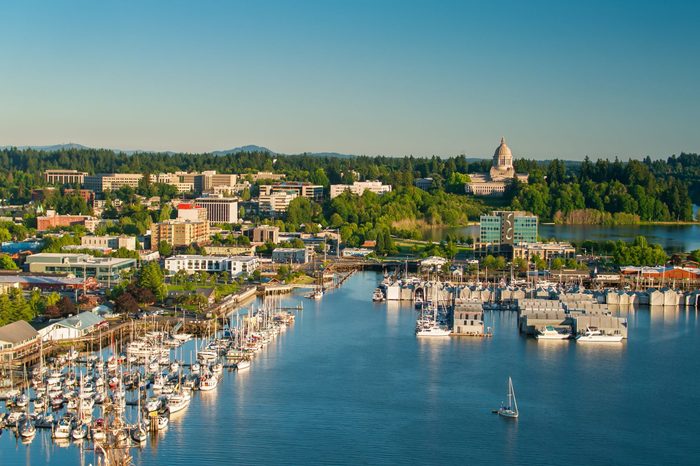
Olympia, Washington
Olympia’s first non-Indigenous settlers were pioneers Levi Lathrop Smith and Edmund Sylvester, who claimed the town site in 1848, naming it Smither (and later Smithfield), after themselves. In 1851, after Smith’s death, it was renamed Olympia on the suggestion of local resident Colonel Isaac N. Ebey, in recognition of the view of the majestic Olympia Mountains, which brought to mind the mythical peak of Mount Olympus in Greece. Olympia was designated the territorial capital in 1853 and the state capital in 1889.
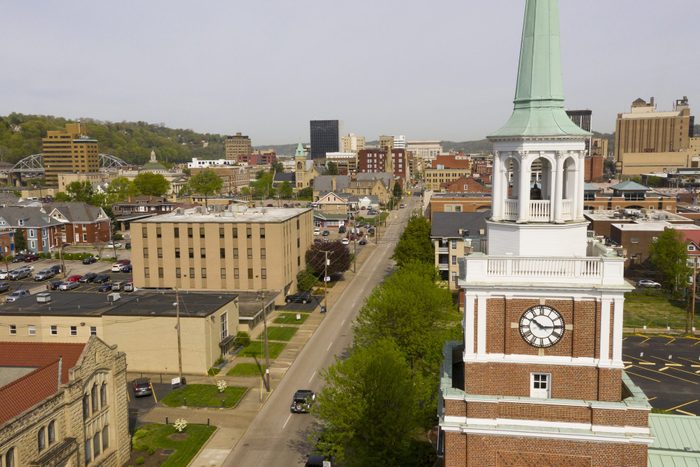
Charleston, West Virginia
Not to be confused with the better known city of Charleston, South Carolina, West Virginia’s capital began as a protective fort in 1788 called Fort Lee. It had been built by Colonel George Clenendin and named for Virginia’s governor Henry Lee, the father of Robert E. Lee. The community that had grown around Fort Lee was chartered as a town known as Charles Town, named after Clenendin’s father, who had died there in 1790. In 1818, the name was shortened to Charleston. West Virginia split from Virginia to become its own state during the Civil War in 1863. For the next 14 years the capital moved between Charleston and Wheeling, until Charleston was selected as the permanent capital in 1877.
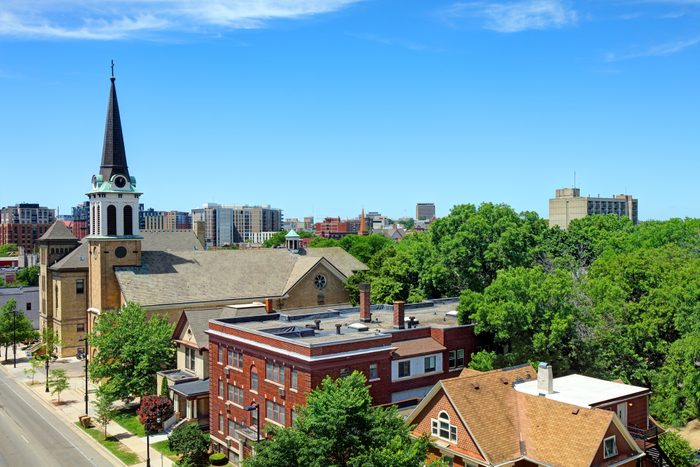
Madison, Wisconsin
In 1829, James Duane Doty, a federal judge, land speculator and territorial governor, purchased more than 1,000 acres of land in the area known as the Four Lakes region. He envisioned a city, put it forth as the location for the new territorial capital in 1836 and named it after James Madison, the United States founder and fourth president, who had died that same year. Madison retained its capital status when Wisconsin became a state in 1848. Fun fact: Doty also named the streets of Madison after the 38 other signers of the U.S. Constitution.

Cheyenne, Wyoming
General Grenville Dodge established Cheyenne as the first Union Pacific Railroad town site in the region in 1867. It was referred to as “Crow Creek Crossing” for the planned bridge that would cross the local creek, but the name of the town was changed to Cheyenne for the Great Plains Indigenous tribe of the same name. Some say the word is from the Lakota language meaning “people who speak a different language.” Cheyenne was selected as the territorial capital in 1869, and it remained the capital when Wyoming became a state in 1890. Today, the historic city offers one of the most romantic hotels you’ll find anywhere.
